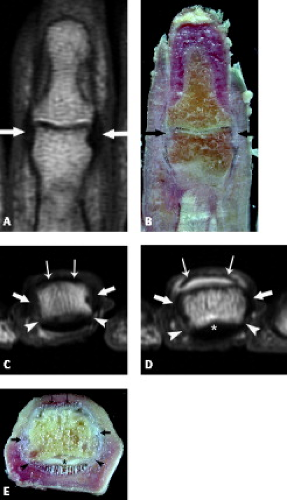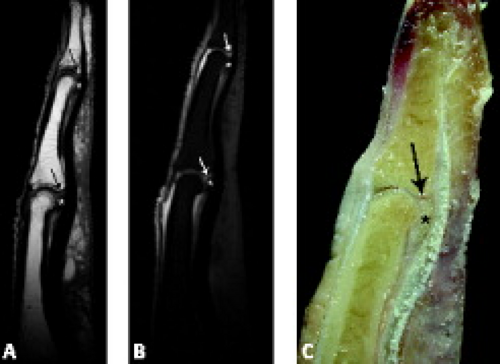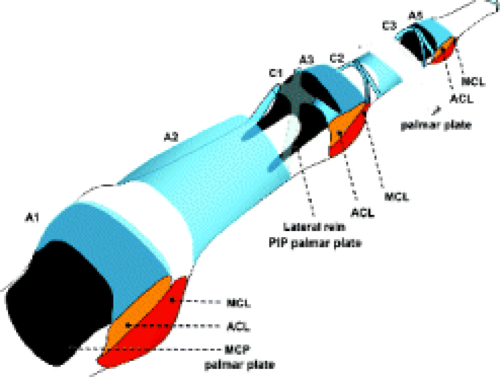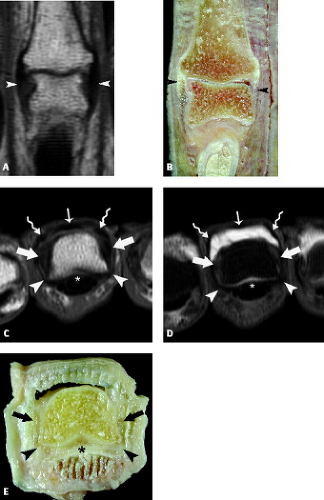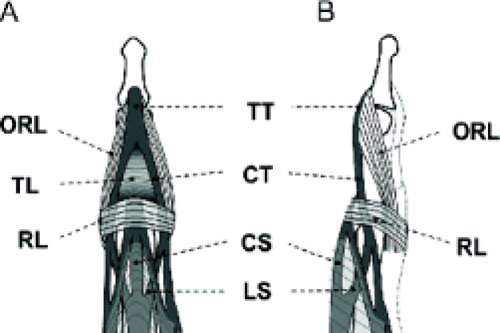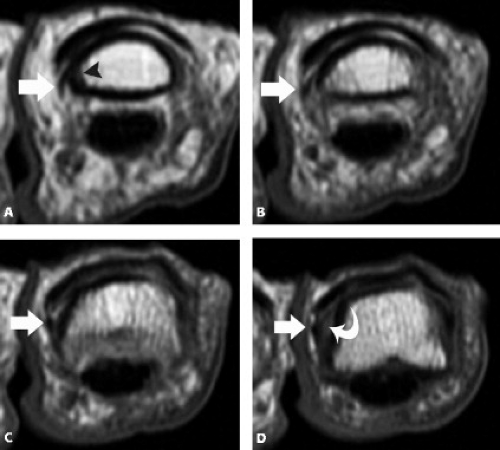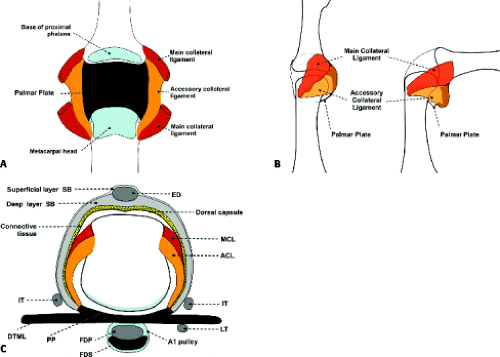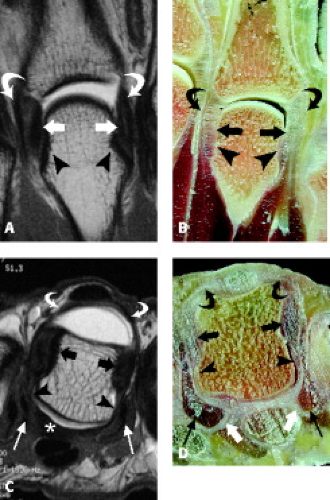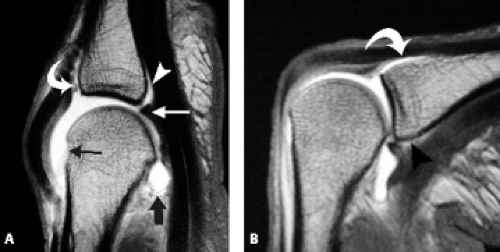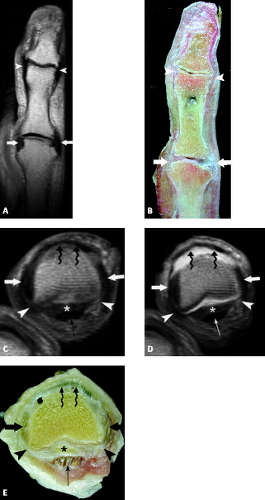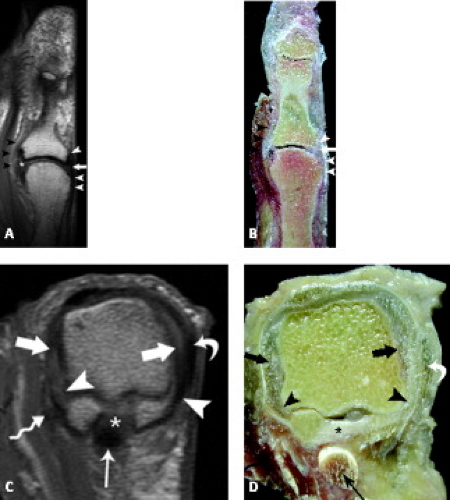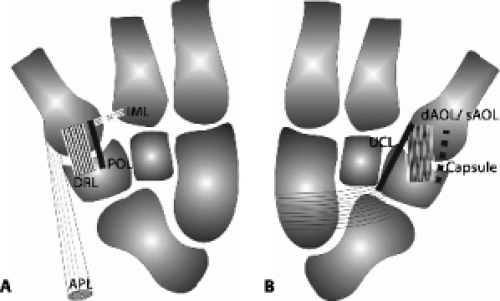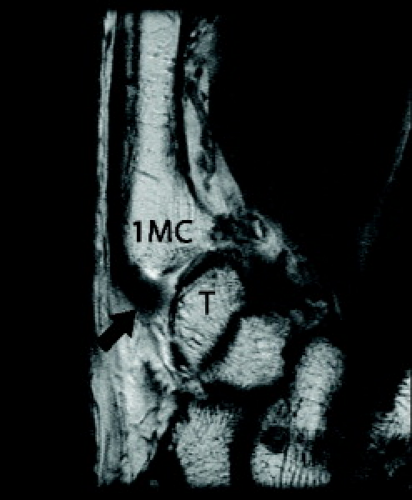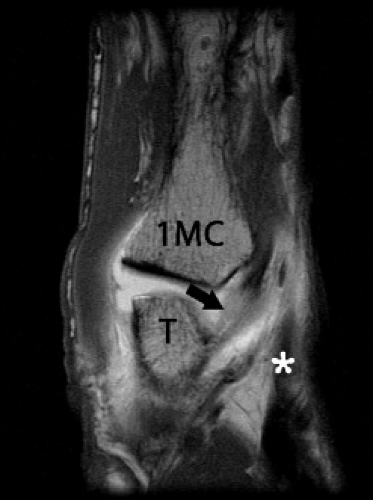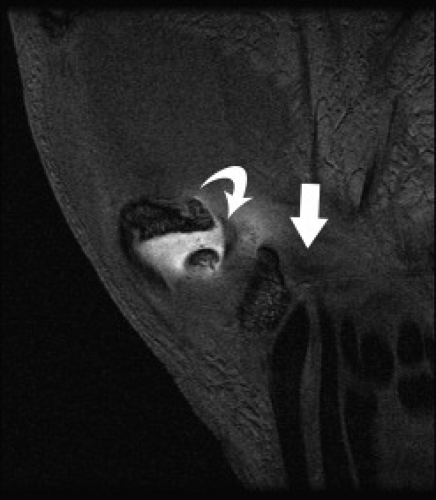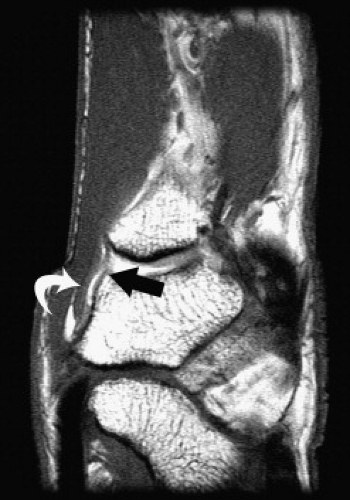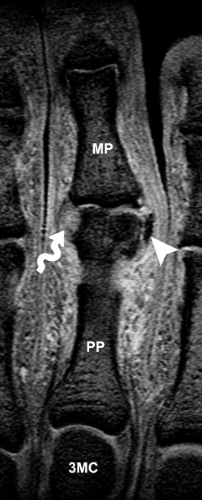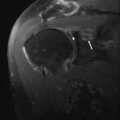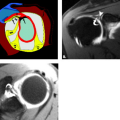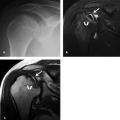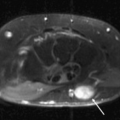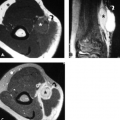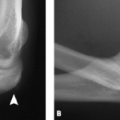Distal Interphalangeal Joint Anatomy
The distal interphalangeal joint is formed by the junction of the base of the distal phalanx with the head of the middle phalanx. The head of the middle phalanx has a bicondylar smooth surface with an intercondylar depression. It engages an elevated anteroposterior ridge that comprises the base of the distal phalanx. The articular surface of the head of the middle phalanx extends dorsally for an extensive distance, reflecting the passive hyperextension possible at the joint. Volarly, the articular surface permits flexion to 90 degrees. The articulation is held together by a capsule that surrounds the cartilaginous surfaces of the joint.
The capsular anatomy of this articulation is complicated by contributions from both ligaments and tendon attachments, which serve to stabilize the joint, hence the term tendinocapsuloligamentous unit. The capsule is reinforced laterally by thick collateral ligaments that insert into the sides of the head of the middle phalanx and run in a distal and volar direction for insertion into the laterovolar tubercle of the base of the distal phalanx (Fig. 18.1). Accessory collateral ligaments are more volar and extend from the sides of the phalangeal head proximally to the sides of the palmar plate distally. The palmar plate provides for volar stability and serves as a floor for the flexor digitorum profundus tendon. This plate of fibrocartilage blends imperceptibly into the nonarticular surface of the base of the distal phalanx and coalesces with the fibers of the flexor digitorum profundus (FDP) tendon attachment. Proximally the plate is attached to the neck of the middle phalanx, but there are no “check rein” ligaments, so hyperextension of the joint is permitted (Fig. 18.2).
The fibrous tunnel of the flexor tendons, the pulley system, also participates in the formation of the tendinocapsuloligamentous unit of the distal interphalangeal, (DIP) adhering to the palmar plate. The insertion of the FDP adds further to the complexity of the capsular anatomy. Before its insertion into the base of the distal phalanx, the FDP tendon fans out over the entire width of the joint and can divide longitudinally into two terminal tendons instead of one. The divided tendon is inserted into the entire width of the base of the distal phalanx, blending with the distal fibers of the palmar plate, periosteum, and even sending fibrous extensions into the fat pad of the finger tip.
Over the joint, the FDP is completely free and glides smoothly within its protective fibrous tunnel. It is connected with the palmar plate through nonrestricting short vincula tendinum for the purposes of blood supply. Immediately beneath the palmar plate, numerous small foramina can be identified at the volar base of the distal phalanx. These foramina permit the passage of multiple nutrient arteries that may prove more important in vascularizing the middle phalanx than the conventional nutrient artery that enters its shaft.
The dorsum of the joint has no reinforcing ligament, although the terminal part of the extensor apparatus of the finger serves as a reinforcement firmly adhering to the capsule between the collateral ligaments. The insertion of the extensor apparatus is broad-based, blending into the capsular fibers of the DIP as well as into adjacent periosteum.
Both the volar and dorsal aspects of the joint capsule display intra-articular thickening. The dorsal capsular thickening protrudes into the dorsal joint between the base of the distal phalanx and the head of the proximal phalanx. The volar thickening fills the space between the volar part of the distal phalanx and the head of the middle phalanx. The interior of the joint is covered with a thin synovial membrane that can protrude into the joint in the form of small diverticuli.
To reinforce the concept that every articulation is surrounded by a fibrous envelope, even the extensor apparatus and the FDP are connected by a network of fibers that run parallel to the collateral ligaments. This fibrous network extends between the dorsal extensor apparatus and the volar FDP. They are more superficial in nature than the collateral ligaments and serve to anchor the extensor apparatus to the FDP in the region of the DIP without restricting motion.
On MR images, normal collateral ligaments appear as sharply defined, linear, low-signal–intensity bands. They are optimally visualized in the coronal imaging plane. The volar plate is triangular in morphology and low in signal intensity. It is best identified in the sagittal imaging plane. The fibrous tunnel of the flexor tendons (at the level of the DIP, the A5 pulley) is a low-signal–intensity band that extends from the tendon to the volar plate. This structure is best localized in the axial imaging plane.
Proximal Interphalangeal Joint Anatomy
The proximal interphalangeal joint differs from DIP in the connections between the ligaments and the extensor and flexor systems. The capsule of this joint is reinforced by two sets of collateral ligaments (radial and ulnar), corresponding accessory collateral ligaments, the volar plate, and extensor mechanism (Fig. 18.3).
The collateral ligament complex is present at both the radial and ulnar sides of the articulation and consists of the collateral ligament proper as well as an accessory collateral ligament (Fig. 18.4). The collateral ligaments
begin at the dorsolateral and dorsomedial aspects of the head of the proximal phalanx and insert at the volar lateral and medial aspects of the base of the middle phalanx, respectively. The accessory collateral ligaments share a common proximal site of attachment but insert at the volar plate. The proper collateral ligament is taut in flexion, whereas the accessory collateral ligament is taut in extension.
begin at the dorsolateral and dorsomedial aspects of the head of the proximal phalanx and insert at the volar lateral and medial aspects of the base of the middle phalanx, respectively. The accessory collateral ligaments share a common proximal site of attachment but insert at the volar plate. The proper collateral ligament is taut in flexion, whereas the accessory collateral ligament is taut in extension.
The volar plate is a thick fibrocartilaginous structure that constitutes the palmar aspect of the proximal inter
phalangeal (PIP) joint capsule. Distally, there is no significant attachment of the volar plate to the middle phalanx. In the central portion of the base of the middle phalanx, the volar plate is loosely attached to the periosteum. This results in the formation of a meniscus of fibrocartilage comprising the volar plate with a recess between it and the volar articular surface of the middle phalanx. This anatomic arrangement permits the plate to retract from the base of the middle phalanx when the joint is flexed. Proximally, the volar plate is firmly anchored to the bone just inside the second annular pulley (A2) and confluent with the origin of the first cruciate pulley (C1). The attachment of the volar plate to the proximal phalanx is more elastic than in the DIP and is U-shaped as a result of two lateral bands, which are called the “check rein” ligaments (Fig. 18.5). The volar plate prevents hyperextension of the PIP joint.
phalangeal (PIP) joint capsule. Distally, there is no significant attachment of the volar plate to the middle phalanx. In the central portion of the base of the middle phalanx, the volar plate is loosely attached to the periosteum. This results in the formation of a meniscus of fibrocartilage comprising the volar plate with a recess between it and the volar articular surface of the middle phalanx. This anatomic arrangement permits the plate to retract from the base of the middle phalanx when the joint is flexed. Proximally, the volar plate is firmly anchored to the bone just inside the second annular pulley (A2) and confluent with the origin of the first cruciate pulley (C1). The attachment of the volar plate to the proximal phalanx is more elastic than in the DIP and is U-shaped as a result of two lateral bands, which are called the “check rein” ligaments (Fig. 18.5). The volar plate prevents hyperextension of the PIP joint.
Dorsally, the PIP joint is stabilized by the dorsal extensor apparatus, including the central slip inserting on the dorsal tubercle of the middle phalanx and lateral slips that are connected by retinacular ligaments (Fig. 18.6). The transverse retinacular ligament is composed of thick, strong fascia that originates from the volar aspect of the capsule in the flexor tendon sheath. Most of
the fibers insert in the lateral margin of the lateral tendon, but a few pass dorsally over the extensor tendon and become continuous with those of the opposite side. All fibers of this ligament abut the capsule of the PIP joint, coursing from a volar origin to a dorsal insertion. The ligament seems to act as a stabilizer for the lateral tendon. It also pulls the lateral tendon volar when the finger is flexed. The second retinacular ligament is that of the oblique retinacular ligament. In contrast to the fibers of the transverse retinacular ligament, those of the oblique retinacular ligament appear tendinous in nature. Two parts of the oblique retinacular ligament have been described: the longitudinal cord and the oblique cord. They form a narrow, strong tendinous band. The former extends between the volar lateral ridge of the proximal phalanx and inserts at the level of the collateral ligaments of the PIP (Fig. 18.7). The oblique cord is thinner and runs from the lateral capsule of the PIP joint dorsally to the lateral bands of the extensor tendons at the level of the middle phalanx. It is visualized in only 50% of patients. Together the components of the oblique retinacular ligament pass parallel to the lateral margin of the lateral extensor tendon and along the long axis of the phalanx. This ligament passes volar to the axis of rotation of the PIP. Although many variations in the anatomy of this ligament can occur, the ulnar aspect of the ring finger proves most constant (1, 2).
the fibers insert in the lateral margin of the lateral tendon, but a few pass dorsally over the extensor tendon and become continuous with those of the opposite side. All fibers of this ligament abut the capsule of the PIP joint, coursing from a volar origin to a dorsal insertion. The ligament seems to act as a stabilizer for the lateral tendon. It also pulls the lateral tendon volar when the finger is flexed. The second retinacular ligament is that of the oblique retinacular ligament. In contrast to the fibers of the transverse retinacular ligament, those of the oblique retinacular ligament appear tendinous in nature. Two parts of the oblique retinacular ligament have been described: the longitudinal cord and the oblique cord. They form a narrow, strong tendinous band. The former extends between the volar lateral ridge of the proximal phalanx and inserts at the level of the collateral ligaments of the PIP (Fig. 18.7). The oblique cord is thinner and runs from the lateral capsule of the PIP joint dorsally to the lateral bands of the extensor tendons at the level of the middle phalanx. It is visualized in only 50% of patients. Together the components of the oblique retinacular ligament pass parallel to the lateral margin of the lateral extensor tendon and along the long axis of the phalanx. This ligament passes volar to the axis of rotation of the PIP. Although many variations in the anatomy of this ligament can occur, the ulnar aspect of the ring finger proves most constant (1, 2).
On MR images, normal collateral ligaments appear as sharply defined low-signal–intensity bands that extend from the proximal phalanx to the middle phalanx. They are optimally visualized in the coronal imaging plane. The volar plate is triangular in morphology, low signal intensity, and best identified in the sagittal imaging plane. The pulley system of the flexor tendon is best identified in the axial imaging plane. The anchors of the pulley are linear and low in signal intensity, seen extending from the tendon to the osseous or soft tissue site of attachment. The MRI findings of the check rein ligaments have not been described.
Lesser Metacarpophalangeal Joint Anatomy
Although the supporting structures of the metacarpophalangeal joint (MCP) and the PIP joint are similar, the osseous anatomy of the multiaxial condyloid joint permits flexion, extension, abduction, adduction, and, to a lesser degree, circumduction. The capsular structures of this joint include two collateral ligaments, two accessory collateral ligaments, and a volar plate. Although these structures do stabilize the joint, it is the contraction of the intrinsic muscles of the hand, the tautness of the flexor tendons, and extensor apparatus that prove most important in joint stability (Fig. 18.8).
The collateral ligaments are situated on the radial and ulnar side of each joint and are quite thick. Reinforcing the capsule, these ligaments are taut in flexion and relaxed in extension. The collateral ligaments arise in a depression of the lateral subcapital area of the metacarpal, then run distally toward the base of the proximal phalanx and fan out widely from the lateral tubercle of the base of the proximal phalanx (Fig. 18.9). The accessory collateral ligament arises in the same depression as
the main collateral ligaments but in a more palmar location. Their proximal attachment is inseparable from the main collateral ligaments. The accessory collateral ligament extends distally to the volar plate. This structure is taut in extension and more relaxed in flexion. Dorsally, the collateral ligament blends with the dorsal capsule of the MCP joint (Fig. 18.8).
the main collateral ligaments but in a more palmar location. Their proximal attachment is inseparable from the main collateral ligaments. The accessory collateral ligament extends distally to the volar plate. This structure is taut in extension and more relaxed in flexion. Dorsally, the collateral ligament blends with the dorsal capsule of the MCP joint (Fig. 18.8).
Although it has been shown that the main collateral ligaments about the MCP joint of the fingers are best evaluated in the axial imaging plane in the flexed finger, the authors find the coronal imaging plane in the neutral position to be a practical and useful imaging plane for collateral ligament assessment (3). This is particularly true in the acutely injured finger, in which imaging in the flexed position may not be possible. The accessory bands of the collateral ligaments are best seen in the axial imaging plane in the extended finger.
The volar plate is firmly attached into the volar base of the proximal phalanx. Proximally, it thins out into a flexible membranous ligament that is attached to the volar side of the MCP neck. The volar plate, with its two accessory collateral ligaments, enlarges the joint cavity permitting the head of the MCP to remain in the articular cavity when the joint is in full flexion. A recess can be identified between the two accessory collateral ligament attachments. Although the dorsal surface of the volar plate is in contact with the head of the metacarpal, the volar surface of this ligament is in contact with the flexor tendons. The digital flexor tendon sheaths are maintained against the volar plate by the A1 pulley. The pulley attaches to the junction of the volar plate and the deep transverse metacarpal ligament. The volar plates are connected from the index finger to the fifth finger by the deep transverse metacarpal ligament. This structure continues into the palm of the hand, becoming thinner and blending with the anterior fascia that covers the interosseous muscles. Volar to the transverse metacarpal ligament are the lumbrical muscles, dorsal to the ligament past the tendons of the interosseous muscles.
Transverse T1-weighted spin-echo MR images and arthrograms of joints in extension enable the best visualization of the axial extent of the volar plate, the deep transverse metacarpal ligament, and the A1 pulley attaching to the volar plate. Sagittal T1-weighted spin-echo MR arthrograms of the joints in either flexion or extension enable the best delineation of the shape of the body of the volar plate and its distal attachments as well as the central recess (Fig. 18.10)(3).
In contrast to the PIP and DIP, in which tendons adhere intimately to the capsule, only loose connections exist between the palmar surface of the extensor apparatus and the dorsal aspect of the capsule. These include the sagittal bands, thin bands that extend from the common extensor tendons to the junction of the volar plate and the deep transverse metacarpal ligament (4). The sagittal band can be divided into superficial and deep layers, the former a very thin structure that runs over the extensor tendon joining the deep layer on each side of the tendon. The sagittal bands course between the interosseous tendons and the main collateral ligaments. The connection between the capsule of the joint and the extensor expansion at the level of the MCP appears to serve a double role: to reinforce the to-and-fro action of the extensor expansion over the MCP and to stabilize the midband of the extensor over the center of the joint. Conventional and arthrographic transverse T1-weighted spin-echo MR images of the fingers in extension are the best way to analyze the sagittal bands.
Distal to the sagittal bands, transversely oriented fibers form a triangular lamina that join the tendons of the lumbrical muscles. These fibers are best evaluated on conventional and arthrographic T1-weighted spin-echo MR images of the fingers in extension.
Interphalangeal Joint of the Thumb
The interphalangeal joint of the thumb is formed by the base of the distal phalanx and the head of the proximal phalanx. It is a hinge joint with a strong capsule and ligaments permitting minimal lateral motion (Fig. 18.11). The capsule is reinforced by two collateral ligaments and their extensions, the accessory collateral ligaments, into the volar fibrocartilaginous plate. The tendon of the flexor pollicis longus passes over the plate to reach its insertion, which occurs over a wide and sometimes deeply excavated surface of the volar phalangeal base. A sesamoid embedded in the tendon proximal to the base of the phalanx is occasionally present. At the dorsal aspect of the joint, the extension of the fibers of extensor pollicis longus and, in some cases, the combined fibers of extensor pollicis longus and brevis adhere to the capsule of the joint.
Metacarpophalangeal Joint Anatomy of the Thumb
The MCP joint of the thumb is a condylar-type articulation that allows several types of motion, including flexion and extension. This joint is formed by the connection of the metacarpal head and the base of the proximal phalanx with the addition of two sesamoid bones. The capsule uniting the osseous structures is thin dorsally and thicker on the volar surface (Fig. 18.12). It is reinforced on each side by collateral and accessory collateral ligaments (Fig. 18.13). Distally, each collateral ligament attaches both to the base of the proximal phalanx and is sometimes referred as to the cord portion of the collateral ligament complex. The accessory collateral ligament extends to the volar surface of the joint to the region of the capsule where the sesamoids are embedded. The portion of the capsule that accommodates the sesamoids is referred to as the intersesamoid ligament. It has also been referred to as the volar plate of the MCP joint. In addition, at the palmar aspect of the joint, there are palmar ulnar and palmar radial longitudinal ligaments that reinforce the posterior capsule (Fig. 18.12). The tunnel of the flexor pollicis longus is intimately connected to the volar plate. The dorsum of the joint is in contact with the tendinous attachments of the extensor pollicis longus and brevis (long muscles of the thumb) as well as the abductor pollicis brevis and flexor pollicis brevis. The abductor pollicis brevis and flexor pollicis brevis, in conjunction with the opponens pollicis, are referred to as the short muscles of the thumb or the muscles of the thenar eminence.
Although the distal attachment sites of abductor pollicis brevis and the flexor pollicis brevis have an intimate spatial relationship with the radial capsule of the thumb, it is the relationship of the adductor pollicis attachment to the ulnar capsule that holds clinical significance. It is the deepest muscle of the thenar eminence and arises by two heads, transverse and oblique, that ultimately converge to a short tendon that attaches at the ulnar side of the thumb. This attachment is superficial to the ulnar collateral ligament and must be closely examined in the setting of ulnar collateral ligament injury (Fig. 18.12).
Carpometacarpal Joint Anatomy of the Thumb
The trapeziometacarpal (TMC) joint is described as a sellar joint between the first metacarpal base and the trapezium. The mobility of this articulation is a reflection of its extensive articular surface and thick but loose fibrous capsuloligamentous structure (5). The TMC is a common site of trauma as well as chronic degenerative change in the absence of a history of an inciting traumatic event. The TMC joint is the site most frequently requiring surgical reconstruction in the osteoarthritic upper extremity (5, 6). Anatomic studies of the TMC joint have emphasized the role of the stabilizing ligaments (6–10).
The following six ligaments about the TMC joint are generally recognized: the dorsoradial ligament (DRL), the posterior oblique ligament (POL), the intermetacarpal ligament (IML), the ulnar collateral ligament (UCL), the superficial anterior oblique ligament (sAOL), and the deep anterior oblique ligament (dAOL). The anterior oblique ligament is also referred as to the beak or volar ligament. The DRL, POL, and IML are attached to the dorsal aspect of the joint; the UCL, sAOL, and dAOL to the volar aspect of the TMC joint (Fig. 18.14).
The DRL is a wide and short-spanning capsular ligament that attaches to the dorsoradial tubercle of the
trapezium and dorsal edge of the first metacarpal base (Fig. 18.15). Dorsal instability is usually the result of disruption of this ligament. The POL is a capsular ligament located deep to the extensor pollicis longus tendon. It attaches to the dorsoulnar side of the trapezium and the dorsoulnar aspect of the first metacarpal in conjunction with the DRL (Fig. 18.16). The IML is an extracapsular ligament, which arises from the dorsoradial aspect of the second metacarpal, radial to the extensor carpi radialis longus tendon insertion, and runs toward the volar–ulnar tubercle of the first metacarpal base (Fig. 18.17).
trapezium and dorsal edge of the first metacarpal base (Fig. 18.15). Dorsal instability is usually the result of disruption of this ligament. The POL is a capsular ligament located deep to the extensor pollicis longus tendon. It attaches to the dorsoulnar side of the trapezium and the dorsoulnar aspect of the first metacarpal in conjunction with the DRL (Fig. 18.16). The IML is an extracapsular ligament, which arises from the dorsoradial aspect of the second metacarpal, radial to the extensor carpi radialis longus tendon insertion, and runs toward the volar–ulnar tubercle of the first metacarpal base (Fig. 18.17).
At the volar side of the joint, an extracapsular ligament, the UCL originates from the distal margin of the flexor retinaculum at its ulnar aspect and inserts superficial and ulnar to the sAOL on the volar–ulnar tubercle of the first metacarpal base. It typically overlaps the sAOL by 2 to 3 mm (Fig. 18.18). The sAOL is a capsular ligament that originates from the volar tubercle of the trapezium 0.5 mm proximal to its articular surfaced and from the volar tubercle of the first metacarpal 2 mm distal to its articular margin. This relationship creates a capsular recess between the sAOL and the first metacarpal (Fig. 18.19). It is superficial to the dAOL and has been described as running in a “curtain-like” fashion (7). The dAOL is an intracapsular ligament that inserts at the articular margins of the trapezium and first metacarpal deep to the sAOL (Fig. 18.19). The dAOL, in conjunction with the sAOL, shares the function of stabilizing the TMC joint against volar subluxation of the metacarpal. Because of the dAOL, Bennett’s fracture results in a ligament avulsion rather than pure dislocation. The volar fracture fragment of the Bennett lesion remains attached to the trapezium by the dAOL. Furthermore, laxity of the dAOL has been implicated as an initiating factor in the development and progression of degenerative joint disease at the TMC joint.
In the experience of the authors, the DRL, POL, IML, sAOL, and dAOL are best visualized in the sagittal plane and the UCL is best visualized in the coronal plane. MR arthrography improves visualization of the IML, sAOL, dAOL, and UCL.
Pathology
Finger Proximal Interphalangeal Joint
Collateral Ligament Injury
Collateral ligament injuries appear to be the most common type of ligamentous insufficiency about the finger (11). Isolated injury to the collateral ligaments can occur in the absence of volar plate injury or joint dislocation. In a series of 30 such lesions, McCue et al. (11) documented that the index finger was most commonly injured. The generic “sprained finger” is usually a collateral ligament injury or volar plate injury (12, 13).
The mechanism for a collateral ligament injury includes an abducting or adducting force applied to the PIP joint in the extended finger. Three main injuries may arise in the collateral ligaments: a ligamentous sprain with no loss of articular stability, a partial ligamentous tear with laterolateral articular instability, and a complete ligamentous rupture with major instability and articular subluxation. Treatment may be surgical or conservative.
MRI allows diagnosis of collateral ligament injuries and is important because the examiner can easily convert a partial tear to a complete tear with overly vigorous testing for stability. MRI criteria for diagnosis of a ligament strain include a continuous ligament with surrounding edema in the soft tissues. A partial tear is represented by intrinsic signal intensity within the ligament on fluid-sensitive sequences that parallels that of joint fluid. No complete areas of discontinuity are
identified (Fig. 18.20). Acute full-thickness collateral ligament tears show discontinuity, detachment, or thickening of the ligament together with increased intraligamentous signal intensity on T2-weighted images, suggesting the presence of hemorrhage or edema. Obliteration of the fat planes around the ligament and extravasation of joint fluid into the adjacent soft tissues may also be observed. Chronic tears can be more challenging to diagnose as a result of the lack of surrounding edema; however, thickening of the ligament resulting from scar formation can be seen. Alternatively, an attenuated ligament with a wavy contour can be encountered (12, 14, 15).
identified (Fig. 18.20). Acute full-thickness collateral ligament tears show discontinuity, detachment, or thickening of the ligament together with increased intraligamentous signal intensity on T2-weighted images, suggesting the presence of hemorrhage or edema. Obliteration of the fat planes around the ligament and extravasation of joint fluid into the adjacent soft tissues may also be observed. Chronic tears can be more challenging to diagnose as a result of the lack of surrounding edema; however, thickening of the ligament resulting from scar formation can be seen. Alternatively, an attenuated ligament with a wavy contour can be encountered (12, 14, 15).

